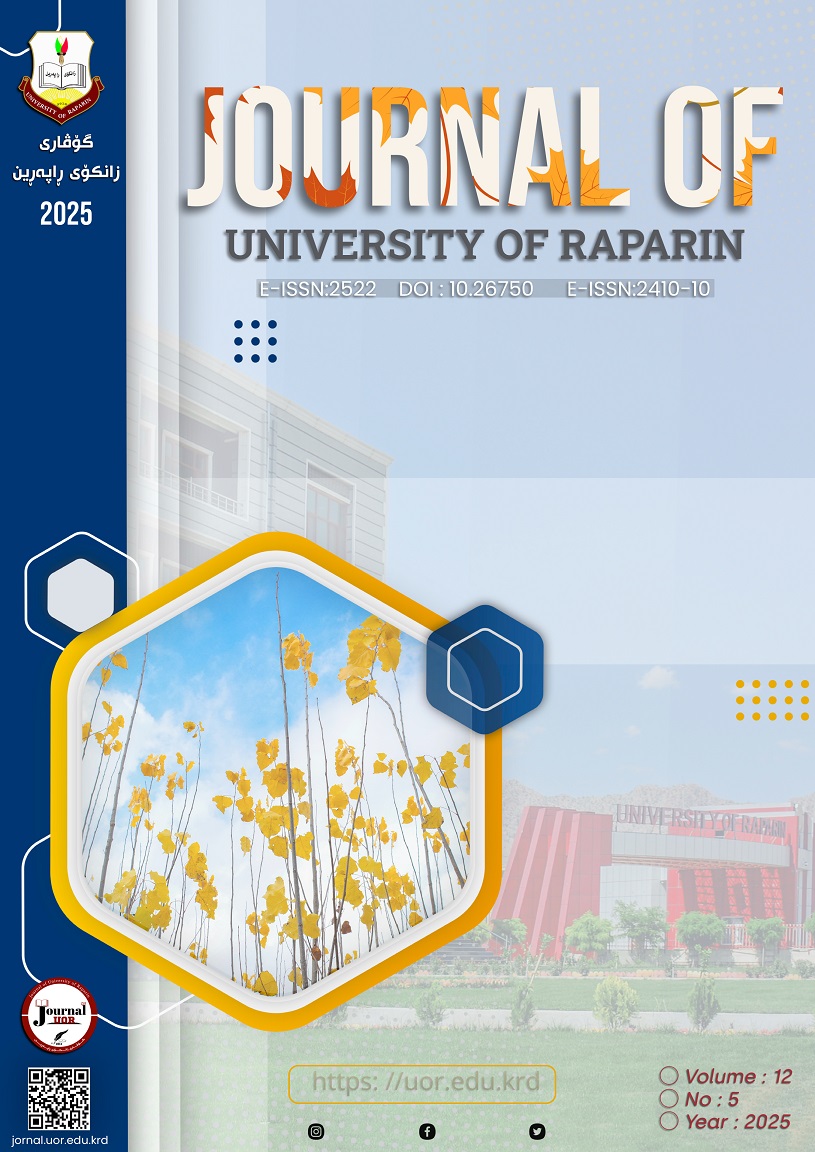الملخص
The main aim of this study is to determine the level each of (exposure to social media and media literacy and to determine the difference in the level each of exposure to social media and media literacy according to variables (Specialist in Education and university.
The researcher used descriptive-survey method and the research community includes students of four universities (Salah al-Din, Duhok, Sulaimani and Halabja) for the academic year (2024-2025) which numbers (70241) students، the sample research consist of (385) student’s those are elected bye (Proportional Stratified Sampling) from each university.
To measure the level of exposure to social media and media literacy, the researcher prepared a scale in collaboration with the supervisor that consists of (8) questions and (24) items and doing psychometric face validity is (%90) and reliability is (.89). For analyze data the researcher used (SPSS.V.27) and used many static articles such (One sample T-test, Independent sample t-test, One way-ANOVA, Pearson correlation, Guttmann and cronbach’s Alpha ) the results showed that the study sample had low exposure to social media and high level of media literacy, and there is a statistically significance difference in the level social media exposure according to educational specialty and university, in the other hand there is’t statically significance the level of media literacy according to educational specialty but there is statically significance according to university, the sulaimani university student’s had higher level media literacy compare than othr universities students. Finally, the researcher made a number of recommendations in the light of the results.
المراجع
بۆکانی، سابیر. (٢٠٢٠)میتۆدی توێژینەوەی زانستی، چاپی دوەم، خانەی چاپ و بڵاوکردنەوەی چوارچرا، سلێمانی
ڕێشاوی، یحیا عمر، حسین، ئۆڕاڵ ابوبکر. (٢٠٢٣). ڕۆڵی پێگە ئەلیکترۆنییە کوردییەکان لە پێکهێنانی هۆشیاری ڕۆشنبیری لای خوێندکارانی زانکۆ لە هەرێمی کوردستاندا، گۆڤاری زانکۆی گەرمیان، ١٠(٢)
عوبەیدوڵڵا، ڕەوان سوبحی. (٢٠٢٣). ڕۆڵی سۆشیال میدیا لە گەشەپێدانی هۆشیاریی سیاسی لای مامۆستایانی زانکۆلە هەرێمی کوردستاندا، دکتۆرانامەی بڵاونەکراوە، کۆلێژی ئاداب زانکۆی صلاح الدین،هەولێر
قەرەداغی، عەتا،. (٢٠٠٧).کاریگەری کەلتوری ئەوان لەسەر کورد،چاپخانەی رون،سلێمانی
مەجزوب، تەڵاڵ، و.مەریون عبدول. (٢٠٠٧). ڕێبازی لێکۆڵینەوە و ئامادەکردنی لێکۆڵینەوەیەکی تیۆری و پراکتیکی،چاپی یەکەم، چاپخانەی خانی، هەولیر
صباح، هیا عمار، سالم، سحر خلیفە. (٢٠٢٤). آلیات الکشف عن الأخبار الزائفە في موقع فیسبوک، دار امجد للنشر والتوزیع، الطبعە الأولی، المملکە الأردنیە الهاشمیە
عبدالکریم، راشد بن حسین. (٢٠٠٧) المناهج الدراسیة وتنمیة ملکات النقد لوسائل الإعلام، السعودیة: الریاض
عوض، عدنان. (٢٠٠٨). مناهج البحث العلمي، الشرکة العربیة المتحدە للتسویق والتوریدات، قاهرة
آسیابی، مشرگ چالشگر کرد، کیایی، زهرا اشکور، سواد. (١٤٠٠). رسانهای در دانشجویان: مطالعه نظامیافته، تعال بالینی،آموزشی – پژوهش، دورە یازدهم.شمارە٣،زمستان
امامی، حسین، سواد. (بدون سال). رسانەای در تئوری و عمل، فصلنامە نقد کتاب اطلاع رسانە وارتباط، سال دوم، شمارە ٥، بهار
حسینزادە، اکبر، استانی، مرتضی محمدی، سواد. (١٣٨٩). رسانەای، ضرورت دنیای امروز. کتاب ماه کلیات، ١٥٣ (اطلاعات، ارتباطات و دانششناسی)، 70-76
داربی، علی. (٢٠١١) درآمدي بر جامعهشناسی ارتباطات فرهنگ و رسانه، تشارات جهاد دانشگاهی، تهران
راودراد،اعظم، خلقتی، مرضیە. (بدون سال) .گونهشناسی اطالعات غلط متنی ـ ویدئویی در رسانههای اجتماعی، فصلنامه علمی وسایل ارتباط جمعی _ رسانه، سال سیودوم / شمارة 1 / 5 5-27(
قاضی مرادی، حسن، درآمدي. (١٣٩٣). بر تفکر انتقادي، تهران: نشر اختران.
نصیری، بهارە، عقیلی،سید وحید. (١٣٩١). بررسی اموزش سواد رسانەای در کشورهای کانادا و ژاپن. فصلنامە نو وریهای اموزشی, ٤١ (علمی پژوهشی)، 137-162
Aldwairi, M., & Alwahedi, A. (2018). Detecting fake news in social media networks. Procedia Computer Science, 141, 215-222. https://doi.org/10.1016/j.procs.2018.10.171
American Psychological Association. (2015). APA dictionary of psychology (2nd ed.). American Psychological Association.
Campan, A., Cuzzocrea, A., & Truta, T. M. (2017, December). Fighting fake news spread in online social networks: Actual trends and future research directions. In 2017 IEEE International Conference on Big Data (Big Data) (pp. 4453-4457). IEEE
Campbell, D. T., & Fiske, D. W. (1959). Convergent and Discriminant Validation by the Multitrait-Multimethod Matrix. Psychological Bulletin, Doi:10.1037/Vol(56). Paper81-105
Colman, A. M. (2015). The Cambridge dictionary of psychology,Cambridge University Press.
Donsbakh, Wolfgang. (2008). "the international encyclopedia of communication, London, Blackwell publishing.
Field, A. (2017). Discovering Statistics Using IBM SPSS Statistics.5th Edition.SAGE Publications.
Godwin, J. (2010). Research Skills for Students. London: Continuum International Publishing Group
Ireton, C., & Posetti, J. (Eds.). (2018). Journalism, fake news & disinformation: Handbook for journalism education and training. Unesco Publishing.
Kerlinger, F.N. (1986). Foundations of Behavioral Research. (3rd ed), Holt, Rinehart, & Winston
Kia, Ali Asghar. (2015). The importance of Media Literacy in the knowledge-base society: The effectiveness of training in the media literacy skills in Iran, Associate professor of Allameh Tabataba'i University, Conference Paper · June 2015.
Koohang, A.; Weiss, E. (2003). Misinformation: Toward Creating a Prevention Framework. Proceedings of Informing Science & Information Technology Education, 109-115.
Lipschultz, J. H. (2023) Social media communication: Concepts, practices, data, law and ethics. Routledge, 4th Edition, New York.
Oxstrand, Barbro. (2009). Media Literacy Education. Paper presented at the Nordmedia09 conference in Karlstad University, Sweden, August 13-15, 2009, revised after the conference
Raboy, Marc. & Padovani, Claudia. (2010). "Mapping Global Media Policy: Concepts, Frameworks, Methods". Journal of Communication, Culture & Critique International Communication Association. 28 (6), 907-923
UNESCO Global Media and Information Literacy Assessment Framework. (2013): Country Readiness and Competencies prepared by UNESCO Communication and Information Sectorin close collaboration with UNESCO Institute for Statistics, Published by United Nations Educational, Scientific and Cultural Organization (UNESCO)7, place de Fontenoy, 75352 Paris 07 SP, Paris, France.
CSI Professor Reece Peck Featured in POLITICO Article on Disinformation and Meta’s Policy Shift | CSI Today
Cambridge Dictionary. (n.d.). Social media. In Cambridge English Dictionary.
https://dictionary.cambridge.org/dictionary/english/social-media
Merriam-Webster. (n.d.). Misinformation. In Merriam-Webster.com dictionary. https://www.merriam-webster.com/dictionary/misinformation

هذا العمل مرخص بموجب Creative Commons Attribution-NonCommercial-NoDerivatives 4.0 International License.
الحقوق الفكرية (c) 2025 Journal of University of Raparin

